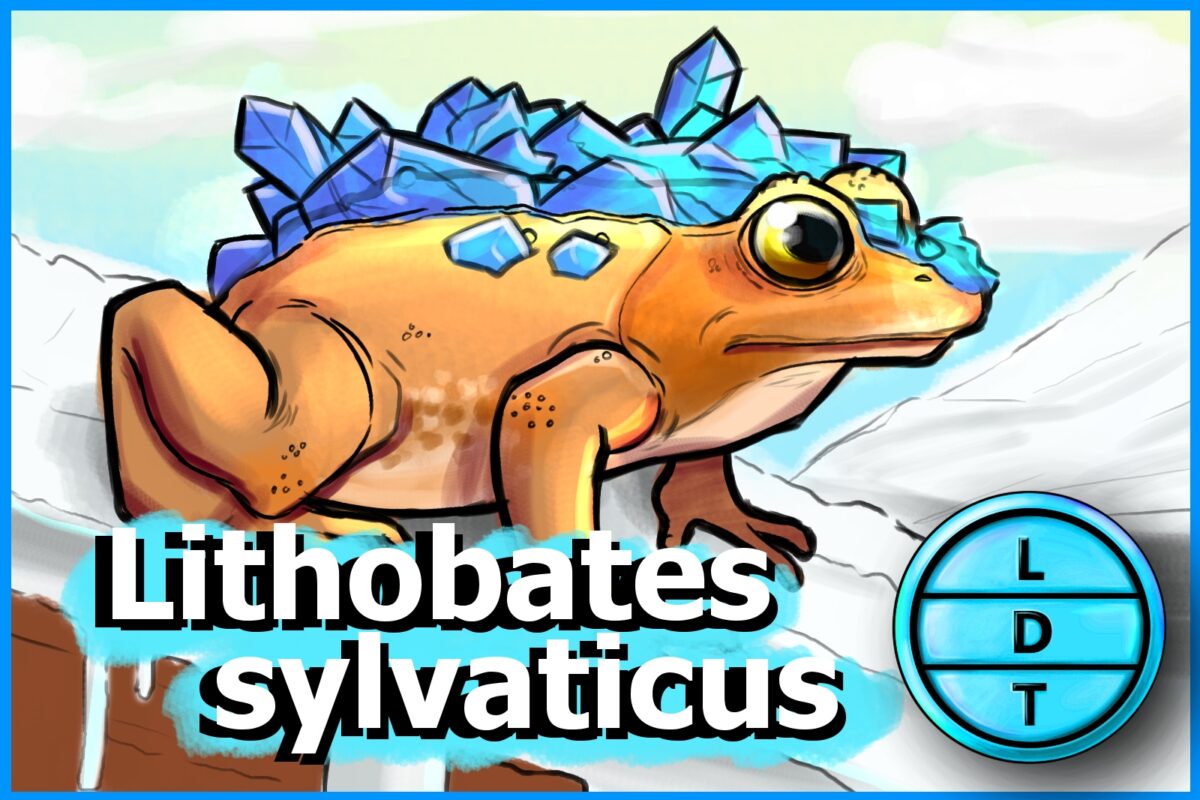“…and today we’re talking about a chill amphibian with a cool pair of sunglasses. But more on that later.”
Being cold blooded is usually fine, as long as you live in a warm-ish area. But what about the chilly-bloods living in the less-than-warm regions of the world? Some dig into the ground, some just die, and others, like the wood frog, take the cold like a champ. Find out how this frigid frog avoids becoming a permanent frogsicle here in Life, Death, and Taxonomy.
Description
- Wood frogs are small brown frogs with khaki tan skin, with a dark brown bandit mask that goes from their nose tip to the back of their upper mouth.
- Some are very dark brown all over.
- They also have dark brown stripes on their legs.
- Their bellies are pale and sometimes light yellow or green.
Measure Up
Welcome to the beloved Measure Up segment. The official listener’s favorite part of the show! The part of the show when we present the animal’s size and dimension in relatable terms through a quiz that’s fun for the whole family. It’s also the part of the show that’s introduced by you when you send in audio of yourself saying, singing, or chittering the words Measure Up into ldtaxonomy at gmail dot com.
- Scottish Terrier
- Afghan hound
- English Sheepdog
- Labrador Retriever
Length
- 51 to 70 mm (2.0 to 2.8 in)
- How many frogs would it take to go the length traveled by Ann Keane when she broke the record for the fastest crossing of Canada on foot by a woman?
- Hint: Keane ran from St John’s Newfoundland to Tofino, British Colombia between April and September of 2002.
- 110,110,629 wood frogs. The trip was 7,831 km (4,866 miles) long.
Weight
- 0.28 oz (7.9 grams)
- How many wood frogs go into the amount of Ferrero Rocher pieces in grams that Leah Shutkever ate in 2:01.7.
- Hint: Shutkever broke the record that was previously held by Canadian Peter “Furious Pete” Czerwinski in 2020.
- 23.7 frogs. She ate 15 Ferrero Rochers totalling 187.5 grams (0.4 pounds)
Fast Facts
- Wood frogs like to live in Northern forests, especially in freshwater wetlands and vernal wetland ponds, which are seasonally occurring bodies of water.
- They are diurnal, and tend to sleep through the night, unless they are breeding.
- They mostly like to eat bugs and invertebrates that can be found on the forest floor.
- Tadpoles are omnivorous and eat algae and other tadpoles, even their own species.
- They mate in the spring and you can hear a chorus of chittering croaks during the mating season.
- The breed in these temporary seasonal pools, which helps them avoid predation from fish and other animals that frequent permanent bodies of water.
- They like to hide in leaf litter, which is aided by their shades of brown coloration.
Major Fact: Frozen Blood
- In case you haven’t noticed, there’s an issue with being a cold-blooded amphibian that lives in Canada and Alaska – it gets cold, real cold
- Being cold-blooded in the cold is a recipe for bad times. Because you’re ectothermic (meaning your body temperature is based on your environment), this means that your body temperature will be pretty darn low in the winter.
- This comes with a trade-off. Mammals and birds are warm-blooded and endothermic (meaning we regulate our own body temperature and don’t let the environment tell us what to do) so being cold or hot isn’t so bad.
- The downside is that warm-blooded beasts have a very limited temperature range that they can survive in.
- If their bodies get too cold or hot – usually just by ten or so degrees, mammals and birds don’t fare too well
- On the other hand, ectotherms can survive a much larger range of body temperatures, but the trade-off is that they need to manage their body heat by finding ways to stay warm or cool off.
- Additionally, ectotherms can often speed up or slow down their metabolisms based on the temperature.
- The wood frog has a different method for surviving the cold though – Their blood (and the water in their body) actually freezes.
- The way that their blood freezes without killing them is a matter of no small amount of chemistry
- The frog generates urea in its tissues as winter approaches. Urea is usually secreted in urine in mammals, but in the wood frog, it interacts with glucose from the liver to limit the amount of ice crystals that form in the tissues and blood.
- Glucose helps keep water inside the cells when it gets cold. In mammals, when the water in the blood turns to ice, which ends up drawing water out of the cells – causing the cells to die.
- So, with these systems in place, wood frogs can survive and thaw back out as long as less than 65 percent of their body water freezes.
- They stay frozen for over seven months at temperatures hovering around 0 degrees F. During this time, their heart stops, their blood obviously doesn’t flow, and they basically function as little frogsicles until they thaw and hop away like everything’s normal.
- Turns out stopping the water in your body from crystalizing when it
Ending: So stick around for winter, don’t let ice crystals form in your blood, and keep your cells full of water like the wood frog here in LDT.

